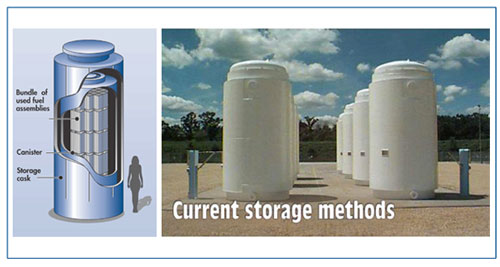Storing: a useful but temporary solution

Dry storage
Once the spent fuel from reactors is sufficiently cool, it is sometimes put into dry storage in the United States, in steel and concrete containers at ground level. Here these containers, or casks, are placed vertically. There are such storage sites close to nuclear plants in 39 states. The techniques guarantee protection against radiation. However, these systems are designed to be temporary. They are often close to cities or industrial areas, and therefore could not be used to isolate waste for thousands of years.
© DOE
Storing means tidying an object away with the intention of getting it out again. Storage, which offers the possibility of retrieving the object that was put away, is by nature reversible. English has a more precise term for this: ‘interim storage’.
In the case of radioactive waste, storing means ‘temporarily depositing radioactive material in a facility designed to guarantee its containment’. Storage implies that it will be monitored. It is not designed to be used indefinitely and should not be used because one does not know what else to do.
Storage has its virtues for the most radioactive material. Storing a high activity package for several decades reduces the amount of heat it releases.
If packages are only warm by the time they are buried, the disposal facilities to be built can be smaller and therefore less expensive. During the storage period, technology will have moved on. Better packages may have been developed. Waste incineration reactors capable of destroying the most toxic and difficult radioactive material may have appeared.
Industrial storage of the most radioactive material is already a reality, with many variants. In the US, spent fuel assemblies are stored at nuclear plants in cooling pools and dry silos. In Germany, Sweden and Switzerland, there are central facilities. In France, spent fuel assemblies and vitrified waste from reprocessing are grouped at Marcoule and La Hague. There are storage facilities in operation for every type of waste, particularly pools for spent fuel and ventilated shafts for vitrified high-level waste.
Storage can be built at ground level or tens of metres below ground in a hillside or mountainside. Ground-level storage generally consists of underground shafts or cells under a building, as at La Hague. These subsurface shafts and cells can been accessed by means of a network of galleries. There is a storage facility of this type at Oskarshamn in Sweden.
Storage appears to be an essential interim stage before the disposal of radioactive waste. In all cases the solutions are temporary, valid for a few decades. Research is being done into long-term storage designed to protect packages and make them retrievable for up to 300 years.
Waiting too long means placing the burden on future generations. The right balance needs to be struck; storage should not be seen as an alternative to disposal, as it is by the opponents of disposal who advocate long-term storage. Long-term storage would involve very careful monitoring, a heavy burden of maintenance, and an obligation to remove the waste at the end. It is not a satisfactory solution as far as our descendants are concerned. Used for too long, the best storage facility becomes the worst disposal facility. Will future generations give more attention to these installations than we give to the catacombs of Paris? The example in 2005 of the dramatic consequences of Hurricane Katrina, aggravated by the US authorities’ negligence over the maintenance of the levees in New Orleans, urges caution.
Other articles on the subject « Waste strategies »
Slow disappearances
Trapping radioactivity until it disappears A scenario for the long-term future of the waste It wi[...]
Oklo : a natural reactor
Nature at work over the last two billion years It was noticed by chance in the 1970s that a urani[...]
Diluting radioactivity
A practice for elements with low levels of toxicity Management of radioactive waste generally foc[...]
Putting it out of reach
Containment and burial when it is not enough to wait Letting time do its work is not sufficient o[...]
Conditioning
Packages for trapping radioactivity… Conditioning means containing the radioactivity and im[...]
Deep geological disposal
Ground-level and deep disposal: a definitive solution Deep disposal of the most radioactive waste[...]
Separating and sorting
Sorting radioactive waste has advantages As with household waste, sorting can prove really useful[...]
Destroy (transmutation)
Transforming radioactive nuclei to make them less troublesome… The incineration of househol[...]
What to transmute?
Transmuting long-lived actinides and fission products Long-lived elements: actinides and fission [...]
Transmuting actinides
Attractive in principle, difficult in practice Destroying actinides using fission reactions is at[...]